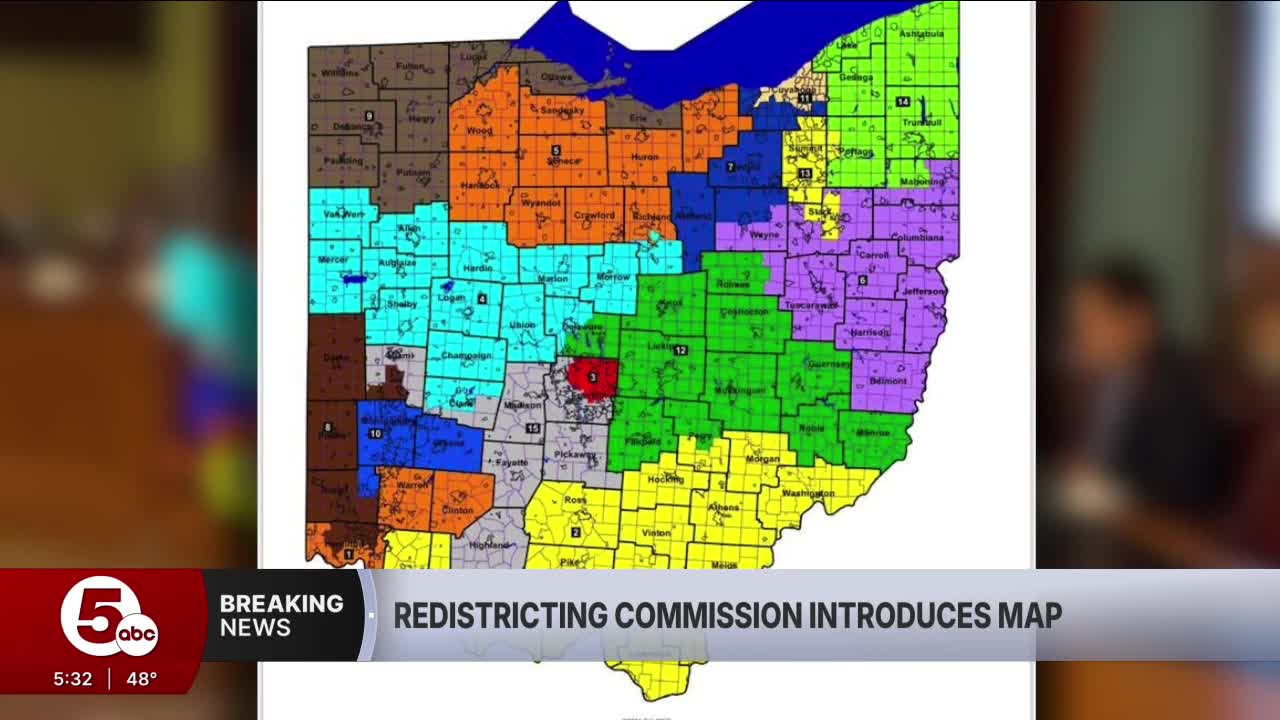COLUMBUS, Ohio — The Ohio Redistricting Commission has introduced and is expected to pass a bipartisan map on Friday, one that makes the districts lean more red but still keeps races relatively competitive.
The map makes several changes to key races. Democratic Reps. Emilia Sykes of District 13 in Northeast Ohio, Marcy Kaptur of District 9 in Northwest Ohio and Greg Landsman of District 1 in Southwest Ohio have been the top GOP targets, according to Republican party leaders.

Ohio's congressional districts are currently composed of 10 Republicans and five Democrats; however, both the Sykes and Kaptur seats were already leaning red. Landsman's was leaning slightly blue. With this anticipated map, it would keep a 12-3 map that already existed in 2022.
Sykes appears to be in the best position of the three, with her seat now slightly leaning blue, but still left in a purple district. Both districts for Landsman and Kaptur get more Republican, but the Cincinnati congressman could be considered a toss-up.
The political shift largely comes from adding deep red Clinton County and red-leaning western Hamilton County to Landsman's District 1.
Watch: WCPO talks to voters in Cleves who would be added to Landsman's district
Kaptur's district would become several points more Republican than it was in 2022.

Nine districts lean Republican, two lean Democratic and four fall in the 45–55% competitive range, according to the commission's analysis.
By passing through the ORC instead of the General Assembly, the map is not subject to a referendum. The commission has another meeting on Friday morning in which they are set to officially pass the map.

Reactions
Many members of the audience were furious that the map was only posted online several minutes after the meeting started.
"You don't care what we say," Columbus resident Andrea Yagotda said. "You made a deal, you're going to stand by it no matter what we have to say."
Gov. Mike DeWine, who did not attend the meeting but stopped by to pull reporters out to do an impromptu gaggle, said that this was a compromise — one he will support.
"Was the idea of a referendum part of the decision on why Republicans put forward a map that, some of the people who are further right say isn't red enough?" I asked the governor.
"Well, I suspect both sides... I think everybody had understood exactly where we were," he responded, noting that if a bipartisan map wasn't passed during the ORC hearings, the resulting plan would have been created by just Republicans in the legislature."What Republicans will get out of this is a sure map that will be done. These are all negotiations, and in negotiations — no one gets what they want."
Not only were citizens mad that DeWine wasn't in attendance, but they were also frustrated that Democrats were going along with the Republicans.
"You all should be ashamed of yourselves, especially you two Democrats," Katy Shanahan, a progressive activist, said before being escorted out for repeatedly asking the ORC to wait for the press to come back into the room to continue hearing public testimony.
ORC Co-Chair Brian Stewart (R-Ashville) explained that both sides win and lose with this map.
"I think most of the feedback has been positive," Stewart said. "I saw some of the 'RINO Hunter 1776' crowd that was a little upset, but generally speaking... There's always going to be some anonymous chatter, but I think that the feedback we've gotten has been overwhelmingly positive."
RINO, or Republican In Name Only, is an insult that some ultra-conservatives use to describe others who masquerade as being part of the GOP, but aren't "Republican enough."
I asked him the same referendum question I asked the governor, and if he was worried about one — which led to this deal.
"I don't know if I'd say worried, but I think certainly the referendum process is part of the constitution," Stewart responded. "We know that if there is a referendum, potentially that freezes us in a current map. It takes candidates for both parties and, you know, kind of leaves them in a limbo for 90 to 120 days, not knowing where they're gonna run, who's going to be their opponents, just kind of freezes the field."
Noting that the system is broken, Democrats defended their decision to support this map in short statements to the press after the hearing ended.
"Now we're down to the end of the 11th hour looking at a map, trying to make a decision on what's the best way forward for our congressional districts — trying to give a fair voice to the people of the state of Ohio in a system that works for politicians picking their people instead of the people picking their politicians," ORC Co-Chair Nickie Antonio (D-Lakewood) said. "And so we are committed to trying to find fairness for the people of Ohio."
Democratic leaders wouldn't take questions from the press, but I kept asking Antonio if she agreed on the map due to fears a referendum would fail.
"I'm not afraid of anything," she responded while walking away.
Follow WEWS statehouse reporter Morgan Trau on Twitter and Facebook.





